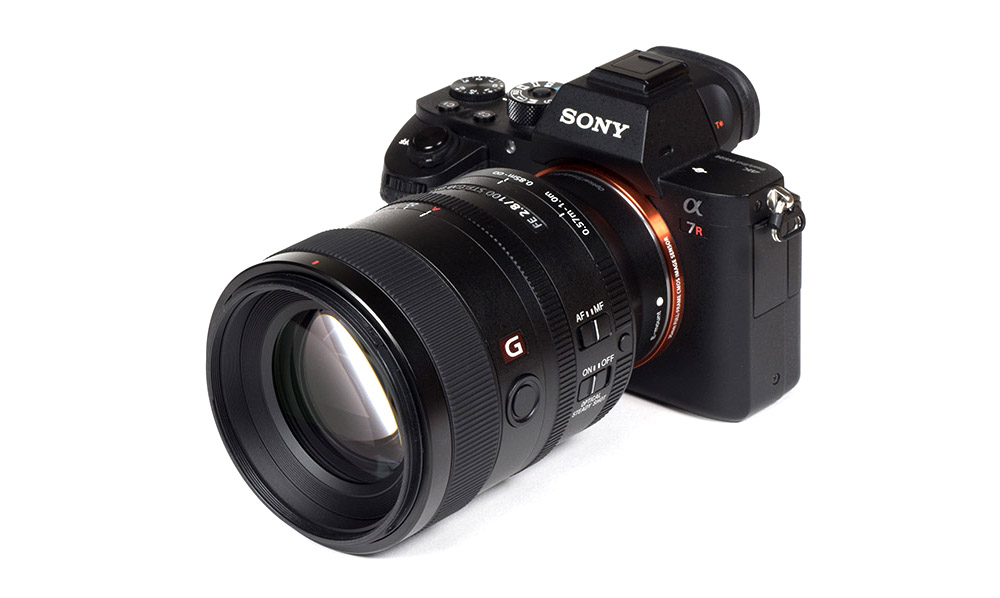by Klaus Schroiff, published August 2017
Introduction
After having reviewed several hundred of lenses, there aren’t too many new lenses that make me truly excited to be honest. However, the Sony FE 100mm f/2.8 STF GM OSS is surely one of them. The high-level specs aren’t all that hot as you may notice – a 100mm f/2.8 is nothing to write home about after all. However, that’s the less interesting aspect here. The real story is described by the “STF” portion in the lens name. STF stands for “Smooth Trans Focus”. STF lenses feature an apodization (APD) element – a graduated neutral-gray filter element. The idea behind it is to soften harsh edges that can be present in the bokeh (out-of-focus blur). We’ll have a look at the effect later on but as you may conclude from the presence of a gray element, it comes at a cost – light loss that is. In case of the Sony lens we are talking about 2 f-stops. This is expressed via a T-value (T = transmission) – thus it’s a 100mm f/2.8 (T/5.6) lens. The T-value does not change the original “speed” (in terms of min. depth-of-field) of the lens – at least not at large apertures. To make things even more complicated regarding the f- and T-values, they range from f/2.8 to f/20 and T/5.6 to T/22 respectively. You may notice that the light loss is variable – at f/20 it’s merely 1/3 of an f-stop because the dark outer portion of the filter is masked by the closed aperture. The camera will always display the T-value which feels a little unfortunate because such a lens is primarily about the depth-of-field rather than the effective speed so it’s a little difficult to estimate the effect on the depth-of-field when stopping down.
The lens is a member of the GM (G-Master) series – thus Sony’s league of high-end lenses. You can certainly feel that when looking at its price tag of 1500 USD/EUR which is quite something for a 100mm f/2.8 lens …
The build quality of the Sony lens is very good indeed. The lens barrel is made of sturdy, high quality plastics based on a metal mount. The physical length remains constant throughout the focus range. It’s also weather-sealed. A fairly unusual feature is the dedicated aperture ring thus you can choose whether to change the aperture on the camera or on the lens. There are also dedicated switches for the AF and OSS plus a focus-lock button. Furthermore there are two dedicated focus ranges – “0.85m-∞” and “0.57m-1.0m”. The latter gives you access to a maximum object magnification of 1:4 which may not quite touch the realms of a true macro lens but which may be “good enough” for many as far as close-focus applications are concerned. A deep barrel-shaped hood is also part of the package.
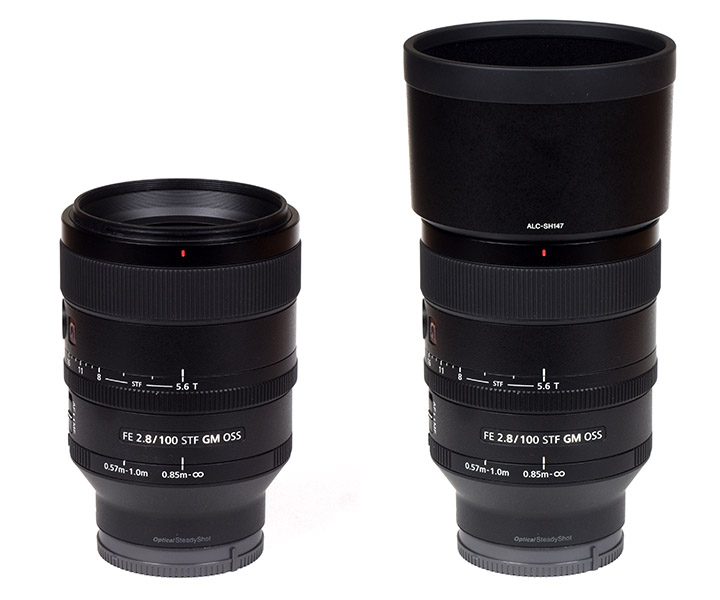
Sony uses its Direct Drive Super Sonic Wave AF Motor (DDSSM) in this lens. Maybe it’s related to the already mentioned light-loss from the APD element but the AF speed is rather moderate. Typical for E-mount lenses, manual focusing works “by-wire”. The focus precision is excellent.
The lens may be slow due to the dampening effect from the APD element but this is at least partially compensated by the OSS (Optical Steady Shot). The OSS can also be combined with select camera’s sensor-shift type image stabilization. On the A7R II we’d rate the image stabilization efficiency between 3 to 4 f-stops.
| Specifications | |
|---|---|
| Optical construction | 14 elements in 10 groups inc. 1x ED, 1x aspherical and 1xAPD elements |
| Number of aperture blades | 11 (circular) |
| min. focus distance | 0.57m (1:4) |
| Dimensions | 85.2×118.1mm |
| Weight | 700g |
| Filter size | 72mm |
| Hood | supplied, barrel-style, bayonet mount |
| Other features | Focus Hold Button, Weather Sealing, Nano AR Coating, Focus Limiter, Aperture Ring, OSS |
Distortion
The Sony FE 100mm f/2.8 STF GM OSS produces a fairly pronounced degree of pincushion distortions (2.4%) in RAW mode. Given the fact that we are talking about a GM lens, this is a little disappointing. Of course, you can also enable image auto-correction, which eliminates the issue.
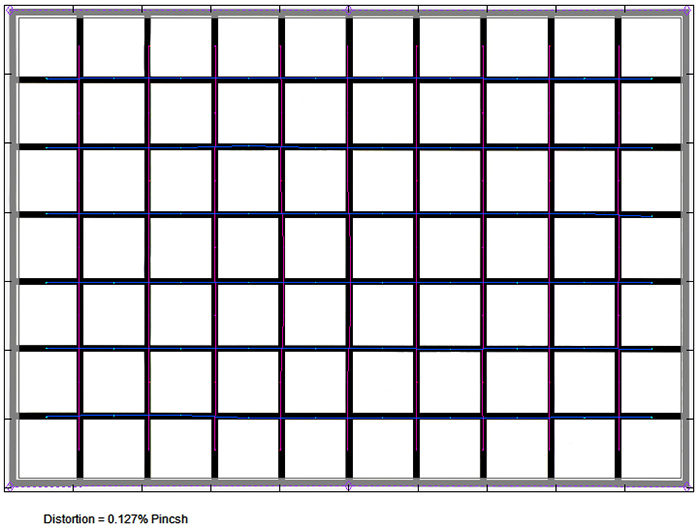
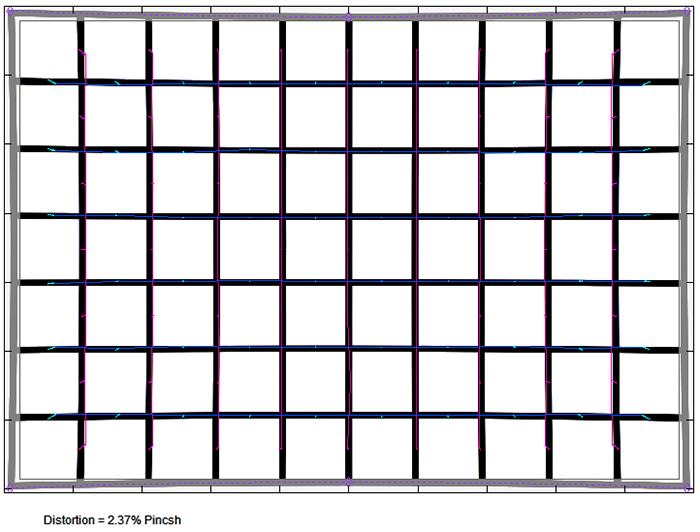
Vignetting
One of the “oddities” of the lens is the vignetting characteristic. Either the lens is over-designed or Sony is applying some tricky under the hood. There is no increased vignetting to speak of at f/2.8 (T/5.6) neither in RAW or auto-corrected mode. The remaining light falloff is negligible.
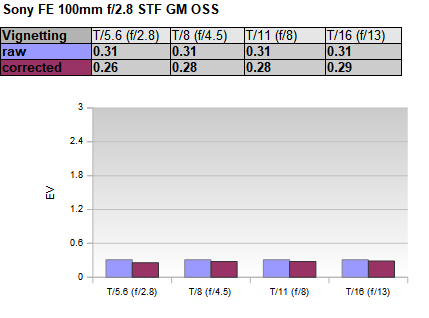
MTF (resolution)
The Sony lens is capable of delivering very sharp results straight from T/5.6. The center quality is outstanding and the outer image field is still good to very good. The peak performance is reached at T/8 where the borders/corners are boosted to very good levels. Diffraction has an impact from T/11 onward. At T/16 the overall quality is still good to very good. However, T/22 (f/20) should be strictly avoided unless really needed.
The centering quality of the tested sample was very good. Field curvature is not an issue.
Please note that we tried to estimate the f-stops of the corresponding T-values. Sony doesn’t provide any guidance for this. The reason why the Sony lens shows this variable T-value to f-stop behaviour isn’t completely clear. We didn’t observe this in other STF lenses that we tested so far. One suggestion is that unlike on other STF lenses, the aperture is further away from the rather extreme APD element which therefore behaves like a secondary aperture. However, we don’t really have an explanation that fully convinces us.
Please note that the MTF results are not directly comparable across the different systems!
Below is a simplified summary of the formal findings. The chart shows line widths per picture height (LW/PH) which can be taken as a measure for sharpness. If you want to know more about the MTF50 figures you may check out the corresponding Imatest Explanations.
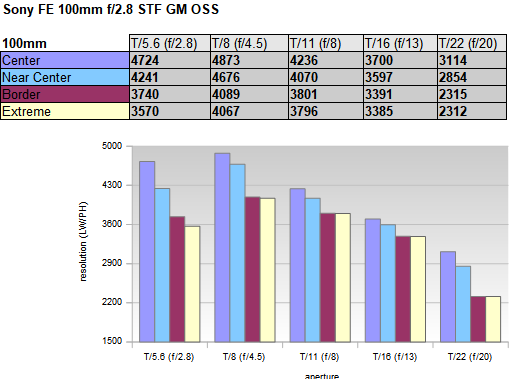
Chromatic Aberrations (CAs)
The Sony lens produces a fairly low amount of lateral CA (color shadows at harsh contrast transitions) starting with an average CA pixel width of 1.3px at T/5.6 increasing to 1.7px at T/22.

Bokeh
Let’s discuss the real purpose of the lens now – the bokeh – thus the quality of the out-of-focus blur.
Out-of-focus highlights are usually rendered as distinctive discs. This is not the case at T/5.6. As you can see below the highlights smoothly dissolve towards their edges (suggesting a very dark outer area of the APD element). This is about as close to perfection as you can get. However, what you can also observe is that the effect is pretty much only visible in full at T/5.6. If you stop down by just 1/3 of an f-stop the effect is almost gone showing the conventional highlight discs again. These highlight discs are still quite nice although they show a bit of an increasing outlining effect the further you stop down. To be fair here – the Sony FE 100mm f/2.8 STF GM OSS is fairly slow thus you will pretty much always prefer to shoot at f/2.8 (T/5.6) anyway.

Just to give you a better idea of what’s happening here – for comparison – below are highlights as generated by the Zeiss FE 55mm f/1.8 (which are rather crappy).

Another difference compare to conventional lenses is the quality of the highlights near the borders/corners. Usually you experience a deterioration of the highlight discs towards “cat eyes” whereas the STF lens is still capable of producing these nicely blurred discs here.

Unsurprisingly the general blur quality is also exceptionally smooth in the focus transition zones of both background and foreground. The blur is symmetrical and maintains a high color fidelity.
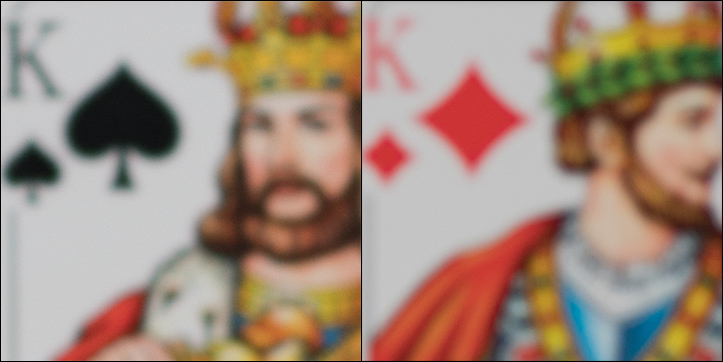
Bokeh Fringing / Longitudinal Chromatic Aberrations (LoCA)
So-called bokeh fringing is an effect that occurs around the focus point (on the Z-axis). It’s visible as halos of different colors in out-of-focus areas – magenta (red + blue) in front of the focus point and green beyond.
The Sony FE 100mm f/2.8 STM GM OSS macro is moderately fast so it’s not overly affected by the issue. You can spot traces of this at T/5.6 but they are gone at T/8.
If you traverse through the aperture range below, you will also recognize that the focus remains static (thus no residual spherical aberrations).
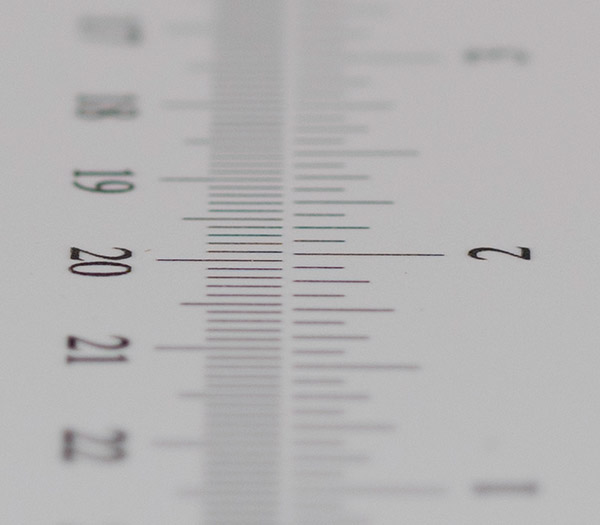
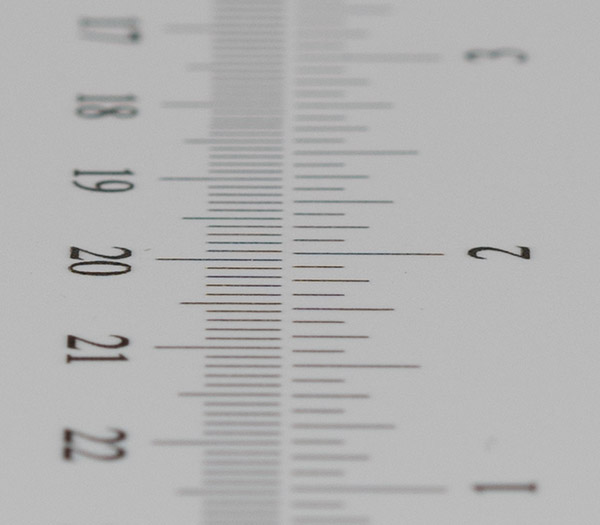
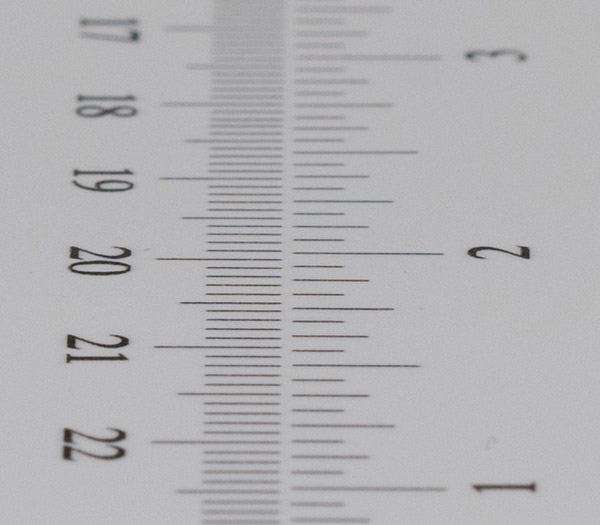
Sample Images
Competition
The Sony FE 100mm f/2.8 STF GM OSS is a unique lens in the Sony lineup thus it’s difficult to compare it to other offerings. However, despite its superb bokeh some users may still prefer lenses that provide a shallower depth-of-field. On the high-end of that scale, there is the Sony FE 85mm f/1.4 GM (2nd to the left below). Honestly speaking the 85mm f/1.4 is probably the better choice for portraits and such. If you prefer something smaller and more light weight, then there are two further options – the Zeiss Batis 85mm f/1.8 (3rd) and the Sony FE 85mm f/1.8 (4th) which are both still substantially faster than the STF lens.

Visual comparison courtesy of camerasize.com.
The Sony FE 100mm f/2.8 STF GM OSS is certainly a controversial lens. In terms of sheer depth-of-field power and speed, it is a mediocre lens. However, the quality of the bokeh is second to none (also compared to STF offerings from other manufacturers). The decision should surely be made based on the target application. Some may argue that this is the perfect wedding or portrait lens. That's, of course, feasible but honestly I, for one, would prefer a faster lens in such scenarios. I'd rather state that the lens is aligned to still life and nature photography where you are often facing very busy and contrasty fore- and backgrounds and this STF lens can kill hard edges like no other. I'd even state that it can substitute a macro lens down to a magnification of 1:4 although that may not be sufficient for critters at least. Other than the superb bokeh, the Sony lens is very sharp at T/5.6 and even more so at T/8. If you look hard you may find some lateral CAs and image distortions aren't perfect either. However, image auto-correction can help here, of course. Strangely vignetting is not an issue even at f/2.8 - something that we haven't seen so far in any other lens (which may raise the question whether Sony applied some trickery under the hood).
The build quality is superb and despite the use of high quality plastics (rather than metal) it certainly deserves Sony's GM designation here. The weather sealing is also aligned to professional use. Interestingly Sony implemented a dedicated aperture ring. Some users may still prefer this but it feels a little bit like a gimmick these days.
It's certainly not a lens you'd choose for sports/action - the AF speed is moderate but still good enough for most other applications.
The APD element is eating 2 f-stops of light so in order to avoid high ISOs, Sony did the right thing and implemented an OSS (optical image stabilizer) which can also work in conjunction with Sony's 5-axis in-body (camera) IS. The efficiency of the IS system is pretty high (3-4 f-stops).
Coming to a final conclusion isn't really easy because you can be very opinionated about the pros and cons of the Sony FE 100mm f/2.8 STF GM OSS. However, in my book it can produce stunning results and it alone is a reason to jump on the Sony bandwagon if you can afford it and if a truly outstanding bokeh is just your thing. Therefore … highly recommended!
-
Optical Quality
-
Build Quality
-
Price / Performance


